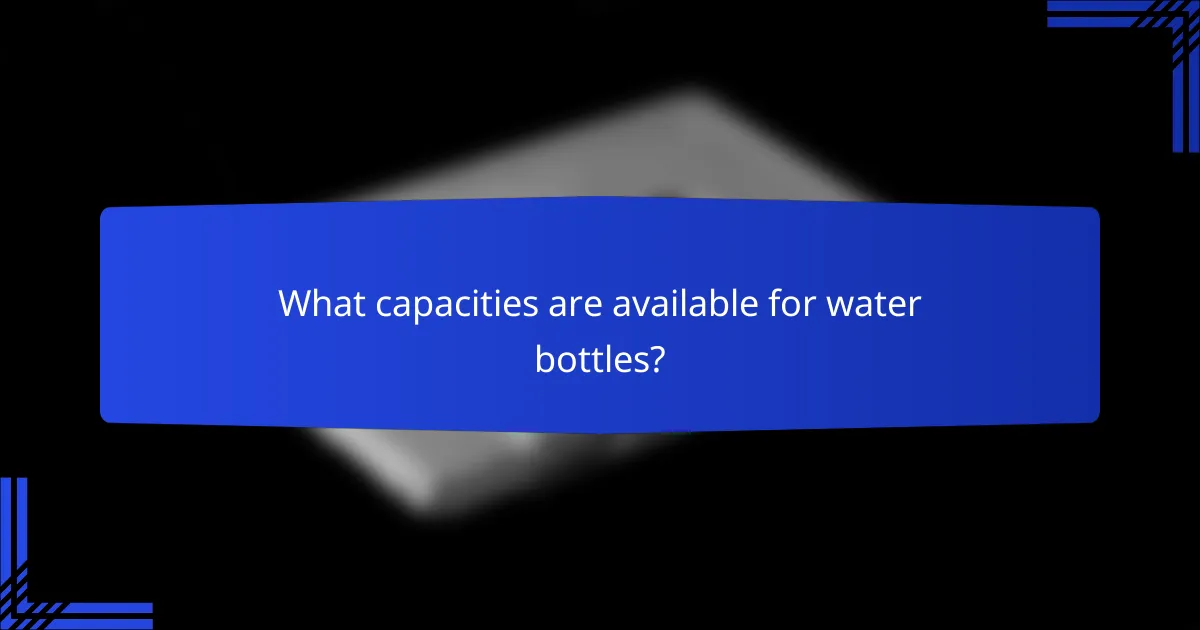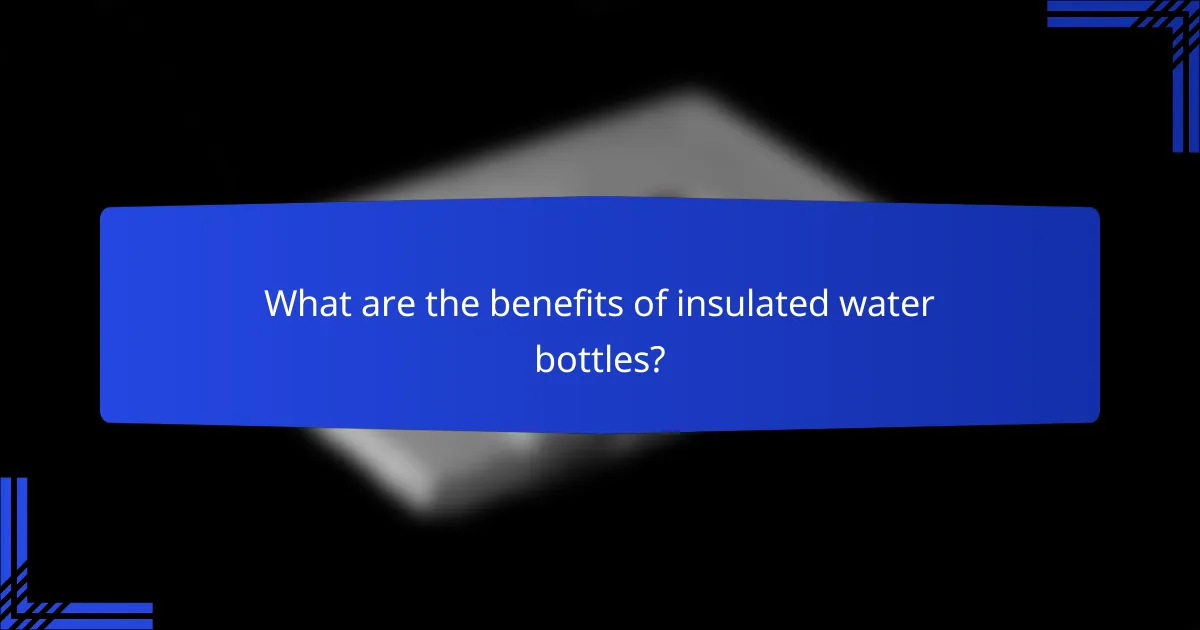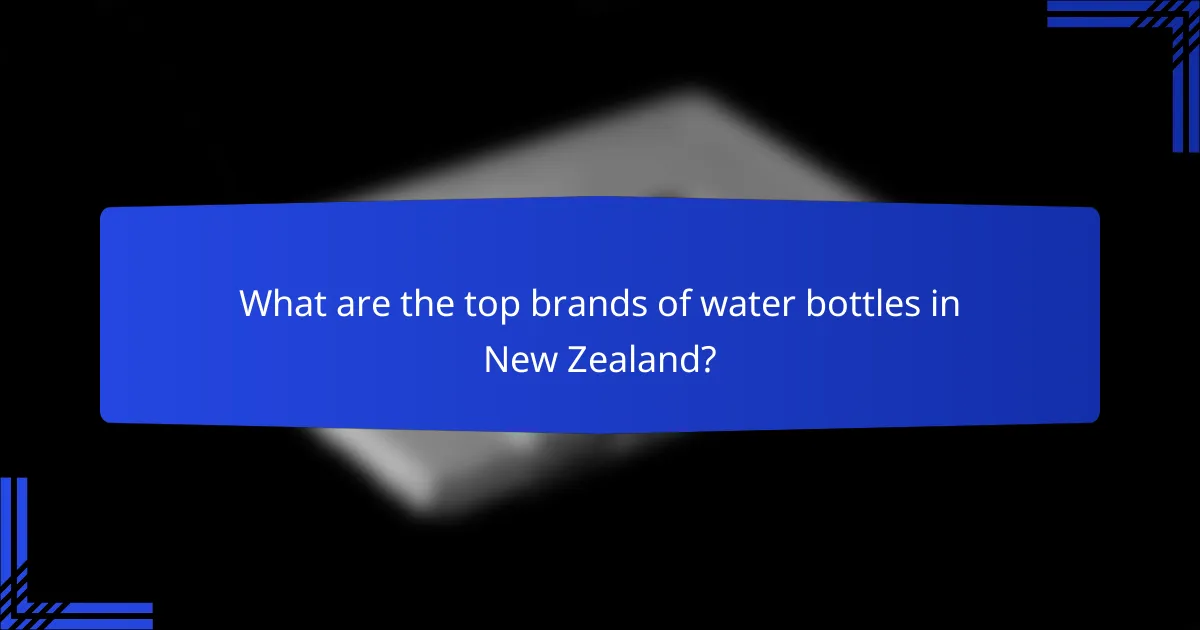Choosing the right water bottle involves considering materials, insulation, and capacity. Common materials like stainless steel, BPA-free plastic, glass, silicone, and aluminum each offer distinct advantages. Insulation plays a crucial role in maintaining beverage temperature, while capacities typically range from 500ml to 2 liters, catering to different hydration needs and portability preferences.

What are the best water bottle materials in New Zealand?
The best water bottle materials in New Zealand include stainless steel, BPA-free plastic, glass, silicone, and aluminum. Each material offers unique benefits and drawbacks, making it essential to choose one that fits your lifestyle and needs.
Stainless steel
Stainless steel water bottles are durable, resistant to rust, and can keep beverages hot or cold for extended periods. They are often insulated, making them a popular choice for outdoor activities and daily use.
When selecting a stainless steel bottle, look for double-walled vacuum insulation for optimal temperature retention. Ensure it is food-grade stainless steel to avoid leaching chemicals into your drink.
BPA-free plastic
BPA-free plastic bottles are lightweight and often more affordable than metal or glass options. They are convenient for everyday use and come in various sizes and designs.
However, they may not keep drinks cold or hot for long periods. Check for recycling symbols and ensure the plastic is free from harmful chemicals to maintain safety and durability.
Glass
Glass water bottles are excellent for those who prefer a pure taste without any metallic or plastic flavors. They are easy to clean and do not retain odors or stains.
While glass bottles are generally heavier and more fragile than other materials, many come with protective silicone sleeves to reduce the risk of breakage. Choose a bottle with a wide mouth for easy filling and cleaning.
Silicone
Silicone water bottles are flexible, collapsible, and lightweight, making them ideal for travel and outdoor activities. They can withstand extreme temperatures and are often dishwasher safe.
However, silicone may not insulate as effectively as stainless steel or glass. Look for high-quality silicone that is food-grade and free from harmful additives to ensure safety.
Aluminum
Aluminum water bottles are lightweight and often come with a protective coating to prevent leaching of metals. They are a good option for those seeking a balance between durability and weight.
Keep in mind that aluminum bottles may not insulate as well as stainless steel. Opt for bottles with a BPA-free lining to ensure your beverages remain safe and taste fresh.

How does insulation affect water bottles?
Insulation in water bottles significantly impacts their ability to maintain the temperature of the contents. Effective insulation keeps beverages hot or cold for extended periods, enhancing user experience and convenience.
Double-wall vacuum insulation
Double-wall vacuum insulation consists of two layers of material with a vacuum in between, minimizing heat transfer. This design can keep drinks hot for several hours and cold for an entire day, making it ideal for outdoor activities or long commutes.
When selecting a bottle with double-wall vacuum insulation, look for reputable brands that offer durable materials, such as stainless steel. These bottles often come in various capacities, typically ranging from 500 ml to 1.5 liters.
Single-wall insulation
Single-wall insulation features only one layer of material, which means it does not offer significant thermal protection. While these bottles are lighter and often less expensive, they are less effective at maintaining temperature, typically keeping drinks cold for a few hours at most.
Single-wall bottles are suitable for short trips or casual use. They are often made from plastic or aluminum and can be found in various sizes, generally from 350 ml to 1 liter.
Thermal performance comparison
When comparing thermal performance, double-wall vacuum insulated bottles outperform single-wall options in both heat retention and cold preservation. For example, a double-wall bottle can keep beverages hot for 6-12 hours, while a single-wall bottle may only manage 1-3 hours.
Consider your needs when choosing between these types. If you require long-lasting temperature control, opt for double-wall vacuum insulation. For lighter, more portable options, single-wall bottles may suffice, especially for short outings.

What capacities are available for water bottles?
Water bottles come in various capacities, typically ranging from 500ml to 2 liters. The choice of capacity affects portability, hydration needs, and usage scenarios.
500ml bottles
500ml bottles are ideal for short outings, such as a quick jog or a visit to the gym. They are lightweight and easily fit into small bags or cup holders.
These bottles are often made from plastic or stainless steel, making them affordable and convenient. However, they may require more frequent refills for extended activities.
1 liter bottles
1 liter bottles strike a balance between portability and hydration, making them suitable for day trips or longer workouts. They provide enough water for moderate activities without being overly cumbersome.
Many 1 liter options feature insulation to keep drinks cold or hot, enhancing the user experience. When choosing, consider whether you prefer a wide mouth for easy filling or a narrow mouth for sipping.
2 liter bottles
2 liter bottles are best for extended outdoor activities, such as hiking or camping, where access to water is limited. They ensure you have enough hydration for longer durations without needing frequent refills.
These larger bottles can be bulkier and heavier, so consider their weight when packing. Many 2 liter bottles are designed with features like built-in handles or straps for easier transport.

What are the benefits of insulated water bottles?
Insulated water bottles offer significant advantages, primarily by maintaining the temperature of beverages for extended periods. They are designed to keep drinks hot or cold, enhancing hydration experiences whether at home, work, or outdoors.
Temperature retention
Insulated water bottles excel in temperature retention, keeping cold drinks chilly for several hours and hot beverages warm for a similar duration. Typically, high-quality insulated bottles can maintain temperatures for 12 hours or more, depending on the model and external conditions.
When choosing a bottle, look for double-walled vacuum insulation, which is the most effective method for minimizing heat transfer. This design prevents heat from escaping or entering the bottle, ensuring your drink stays at the desired temperature.
Durability
Durability is another key benefit of insulated water bottles, as they are often made from robust materials like stainless steel or high-grade plastic. These materials resist dents, scratches, and corrosion, making them suitable for various activities, from hiking to everyday commuting.
When selecting a bottle, consider options with BPA-free materials and a powder-coated finish for added protection against wear and tear. This ensures longevity and safety, particularly for those who use their bottles frequently.
Condensation prevention
Insulated water bottles effectively prevent condensation on their exterior, keeping hands and surfaces dry. This is particularly beneficial in humid conditions or when carrying the bottle in a bag, as it avoids moisture buildup that can damage other items.
To maximize this benefit, ensure the bottle is properly sealed and insulated. High-quality models will not only keep drinks at the right temperature but also eliminate the risk of condensation, enhancing user convenience.

What are the top brands of water bottles in New Zealand?
The top brands of water bottles in New Zealand include Hydro Flask, Swell, Contigo, and CamelBak. These brands are known for their quality materials, insulation capabilities, and various capacities to suit different needs.
Hydro Flask
Hydro Flask is renowned for its double-wall vacuum insulation, which keeps beverages cold for up to 24 hours and hot for up to 12 hours. Their bottles are made from high-grade stainless steel, ensuring durability and resistance to rust.
Available in various sizes, typically ranging from 355 ml to 2.5 liters, Hydro Flask offers options for both casual users and serious outdoor enthusiasts. The wide mouth design allows for easy filling, pouring, and cleaning.
Swell
Swell water bottles are popular for their stylish designs and effective insulation properties. They are made from stainless steel and can keep drinks cold for up to 24 hours and hot for about 12 hours, similar to Hydro Flask.
These bottles come in sizes from 260 ml to 1.9 liters, making them suitable for everyday use or longer excursions. Their unique, insulated construction prevents condensation, keeping the exterior dry and comfortable to hold.
Contigo
Contigo focuses on convenience with its spill-proof designs and easy-to-use lids. Their water bottles often feature a one-handed operation, making them ideal for on-the-go hydration.
Contigo bottles typically range from 500 ml to 1.5 liters in capacity. Many models include features like built-in straws or filters, catering to a variety of preferences and activities.
CamelBak
CamelBak is well-known for its hydration packs and water bottles, particularly among outdoor enthusiasts. Their bottles often come with integrated straws or bite valves, allowing for easy sipping during activities.
With capacities ranging from 500 ml to 1 liter, CamelBak bottles are designed for portability and convenience. They are made from durable materials and are often BPA-free, making them a safe choice for everyday use.

How to choose the right water bottle for your needs?
Choosing the right water bottle depends on factors like material, insulation, and capacity. Consider your lifestyle, intended use, and personal preferences to find the best fit.
Material
Water bottles are commonly made from plastic, stainless steel, or glass. Plastic bottles are lightweight and often less expensive, but may retain odors and are less durable. Stainless steel bottles offer durability and insulation, while glass bottles provide a clean taste but can be heavier and more prone to breakage.
When selecting a material, consider whether you need a bottle that can withstand drops or one that keeps beverages cold or hot for extended periods. Look for BPA-free options in plastic to ensure safety.
Insulation
Insulation is crucial if you want to maintain the temperature of your drinks. Double-walled vacuum insulation is the most effective, keeping beverages cold for hours or hot for a significant duration. Some insulated bottles can keep drinks cold for up to 24 hours and hot for around 12 hours.
For casual use, a non-insulated bottle may suffice, but if you plan on hiking or spending long hours outdoors, investing in an insulated model is advisable. Always check the manufacturer’s claims regarding insulation performance.
Capacity
Water bottle capacity typically ranges from around 350 ml to 2 liters. A smaller bottle is convenient for daily use and portability, while larger bottles are better for extended activities like hiking or sports. Consider how much water you need to stay hydrated throughout the day.
As a rule of thumb, aim for a bottle that allows you to drink at least two liters of water daily, especially during physical activities. Ensure the bottle is easy to carry and fits in your bag or cup holder for convenience.
